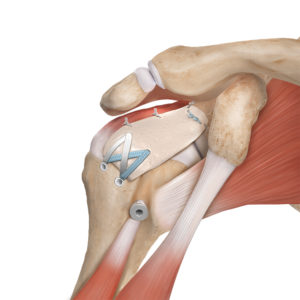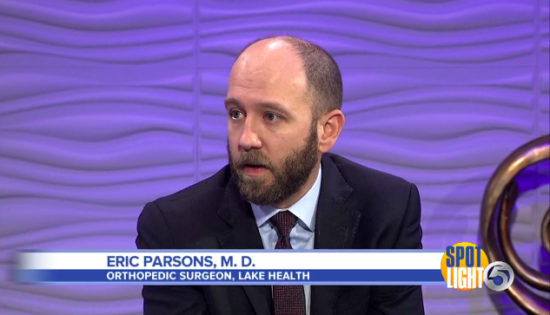Rebuilding a Rotator Cuff
After five years of shoulder pain from what she thought was arthritis, Joan Runestrand, age 69 of Painesville, had to put her golf clubs away and could no longer swim a simple crawl.
Continue reading
The management of rotator cuff tearing is individualized to each patient base on the patient’s current symptoms and future goals. Studies have shown that many patients can achieve satisfactory results and improved shoulder function without surgery even in cases in which the rotator cuff has a full thickness tear.
 Nonoperative treatment of rotator cuff tears involves a multimodal approach aimed at improving shoulder strength and reducing inflammation. Antiinflammatory medications such as ibuprofen and naproxen along with regular icing are simple measures that can provide pain relief. Administration of corticosteroid injections, sometimes called cortisone or steroid injections, can have a profound effect on inflammation and pain and are a mainstay in the nonoperative management of rotator cuff tears.
Nonoperative treatment of rotator cuff tears involves a multimodal approach aimed at improving shoulder strength and reducing inflammation. Antiinflammatory medications such as ibuprofen and naproxen along with regular icing are simple measures that can provide pain relief. Administration of corticosteroid injections, sometimes called cortisone or steroid injections, can have a profound effect on inflammation and pain and are a mainstay in the nonoperative management of rotator cuff tears.
Even in cases where adequate pain relief and shoulder function are realized without surgery this does not indicate that the rotator cuff tear has healed. In fact, extensive study has shown that there is little to no potential for healing of the rotator cuff without surgery. In cases where patients are enjoying satisfactory shoulder function in the face of a documented rotator cuff tear they have in actuality come to a place of less painful coexistence with the tear rather than any degree true healing. What is more, we know that these areas of tearing will increase in size over time so even if there is short term relief with nonoperative care the long term implications of the tear must be considered when devising a treatment strategy.
In many cases rotator cuff tearing will lead to enough pain and functional loss that surgery is recommended. The essence of rotator cuff surgery is reattaching or reanchoring the torn portion of the rotator cuff tendon to the bone from which it separated. Historically this involved large incisions and detachment of the bulkier outer muscle of the shoulder called the deltoid, thus allowing access to the underlying rotator cuff. Violation of the deltoid during this type of open rotator cuff repair contributed to substantial pain following surgery and if the deltoid did not heal completely following surgery shoulder function suffered even if the rotator cuff repair healed well.
The advent of arthroscopic techniques provided improved access to the rotator cuff using small instruments with the assistance of video technology, allowing for treatment of the rotator cuff through tiny incisions without trauma to the overlying deltoid muscle. In addition to reduced pain from the minimally invasive nature of the surgery, arthroscopy affords the surgeon greater visualization of rotator cuff tear patterns as the arthroscope can reach places that are not easily seen with open surgery. Today, virtually all rotator cuff repair surgery is performed through arthroscopic techniques.
After five years of shoulder pain from what she thought was arthritis, Joan Runestrand, age 69 of Painesville, had to put her golf clubs away and could no longer swim a simple crawl.
Continue reading
